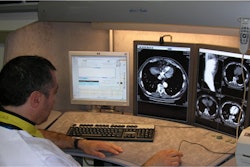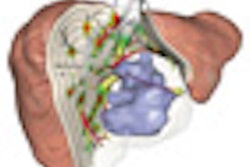VIENNA - Gonad shielding is more trouble than it's worth, concluded Dutch researchers in a study of more than 700 children undergoing x-ray exams of the abdomen and pelvis. Shield placement is rarely correct, they said, and crucial anatomy ends up being covered even when performed correctly, especially in girls.
"The disadvantages prevail over the benefits," the use of shielding results in high rates of repeated exams, and in any case the unprotected dose is low enough not to worry about, said Marij Frantzen, from Maastricht University Medical Center in the Netherlands, in a presentation at the 2011 European Congress of Radiology.
Pelvic shielding has been in use since the 1950s when x-ray doses were much higher and, as a result, the absolute dose reductions were higher as well, she said.
"According to the rules for boys, the shielding must fully cover the gonads ... while other pelvic parts remain uncovered. For girls, the central section of the pelvis had to be covered," again without shielding of the pelvic bones," Frantzen said. However, a large study demonstrated that the ovaries are mostly located laterally beyond the shield in the pelvis and therefore not covered.
The researchers aimed to re-evaluate gonad shielding in terms of total dose reduction and loss of critical anatomy during imaging. Two studies were performed: the first to evaluate positioning of the gonad shields, the second to look at the differences in radiation risk after shielding was discontinued at the facility.
The poor results of gonad shielding were found not only at the study facility, but were also in line with previous studies, Frantzen said in her talk.
"After evaluating the position of the gonad shield in the first study, we concluded that the image quality in daily practice was suboptimal due to the positioning of the shield," she said. However, "the doses were extremely low and, as a consequence, we omitted the shields to improve our image quality."
To optimize the protocols, some additional filtration was added, then the group measured the radiation doses of the exposed areas after deciding to forego the shields.
Results in the first 396 patients, imaged with the use of shielding, showed that for girls it is impossible to protect the ovaries without essential image information because of the varying position of the ovaries in the pelvis. In addition, shielding was poorly placed and often covered the anatomy relevant to the exam, she said.
Study of gonad shields during pediatric abdominopelvic radiography
|
||||||||||||||||||||||||||||||||||||
"We must conclude that the success of our gonad shielding was poor. For boys, correct shielding was found in only 35%, for girls only 10%, and the number of test retakes was very high, especially in the youngest groups," Frantzen said.
The second study analyzed data after halting the practice of gonad shielding, in a comparison of effective and somatic doses. The difference between effective and somatic doses in the contribution of the gonads to the effective dose was calculated in 142 exams, Frantzen said. As part of the protocol optimization, additional filtration (0.11 Cu) was added.
Differences in radiation risk with and without gonad shield
|
The average unshielded dose was 0.019 ± 0.009 mGy to the ovaries and 0.086 ± 0.040 mGy to the testes, which corresponds to a detriment-adjusted hereditary risk of 0.1E6 and 0.5E6, respectively, the authors wrote in an abstract. The unshielded effective dose ranged from 0.006 mSv to 0.011 mSv.
According to the International Commission on Radiological Protection (ICRP), the resulting level of increased risk "is of no concern," Frantzen said.
"We must conclude that there is only 5 microsieverts (0.005 mSv) to gain by fully covering the gonads," Frantzen said. "You can compare that with the background radiation of being one day in the Netherlands."
Complete gonad shielding in girls is impossible without obscuring crucial landmarks, Frantzen said. Gonad shielding in boys was only correct in 35% of the cases and even with correct placement the image quality was suboptimal.
With shielding, the absolute dose reduction level is marginal. However, the use of automatic exposure control does decrease dose and optimizing protocols will have more effect than shielding.
"With modern x-ray systems, the reduction by gonad shielding is negligible," Frantzen said. And considering the potential consequences of loss of diagnostic information, gonad shielding should be discontinued, she added.
After the talk an audience member protested that the key to improved placement of gonad shields, especially in boys, lies in education to improve placement, not in discontinuing shielding. Frantzen responded that previous studies have shown that education and greater care in placement results in only transient, marginal improvements in shielding results.



















